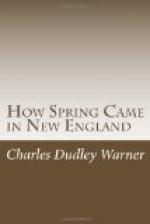Then follows a day of bright sun and blue sky. The birds open the morning with a lively chorus. In spite of Auster, Euroclydon, low pressure, and the government bureau, things have gone forward. By the roadside, where the snow has just melted, the grass is of the color of emerald. The heart leaps to see it. On the lawn there are twenty robins, lively, noisy, worm-seeking. Their yellow breasts contrast with the tender green of the newly-springing clover and herd’s-grass. If they would only stand still, we might think the dandelions had blossomed. On an evergreen-bough, looking at them, sits a graceful bird, whose back is bluer than the sky. There is a red tint on the tips of the boughs of the hard maple. With Nature, color is life. See, already, green, yellow, blue, red! In a few days—is it not so?—through the green masses of the trees will flash the orange of the oriole, the scarlet of the tanager; perhaps tomorrow.
But, in fact, the next day opens a little sourly. It is almost clear overhead: but the clouds thicken on the horizon; they look leaden; they threaten rain. It certainly will rain: the air feels like rain, or snow. By noon it begins to snow, and you hear the desolate cry of the phoebe-bird. It is a fine snow, gentle at first; but it soon drives in swerving lines, for the wind is from the southwest, from the west, from the northeast, from the zenith (one of the ordinary winds of New England), from all points of the compass. The fine snow becomes rain; it becomes large snow; it melts as it falls; it freezes as it falls. At last a storm sets in, and night shuts down upon the bleak scene.
During the night there is a change. It thunders and lightens. Toward morning there is a brilliant display of aurora borealis. This is a sign of colder weather.
The gardener is in despair; so is the sportsman. The trout take no pleasure in biting in such weather.
Paragraphs appear in the newspapers, copied from the paper of last year, saying that this is the most severe spring in thirty years. Every one, in fact, believes that it is, and also that next year the spring will be early. Man is the most gullible of creatures.
And with reason: he trusts his eyes, and not his instinct. During this most sour weather of the year, the anemone blossoms; and, almost immediately after, the fairy pencil, the spring beauty, the dog-tooth violet, and the true violet. In clouds and fog, and rain and snow, and all discouragement, Nature pushes on her forces with progressive haste and rapidity. Before one is aware, all the lawns and meadows are deeply green, the trees are opening their tender leaves. In a burst of sunshine the cherry-trees are white, the Judas-tree is pink, the hawthorns give a sweet smell. The air is full of sweetness; the world, of color.
In the midst of a chilling northeast storm the ground is strewed with the white-and-pink blossoms from the apple-trees. The next day the mercury stands at eighty degrees. Summer has come.




